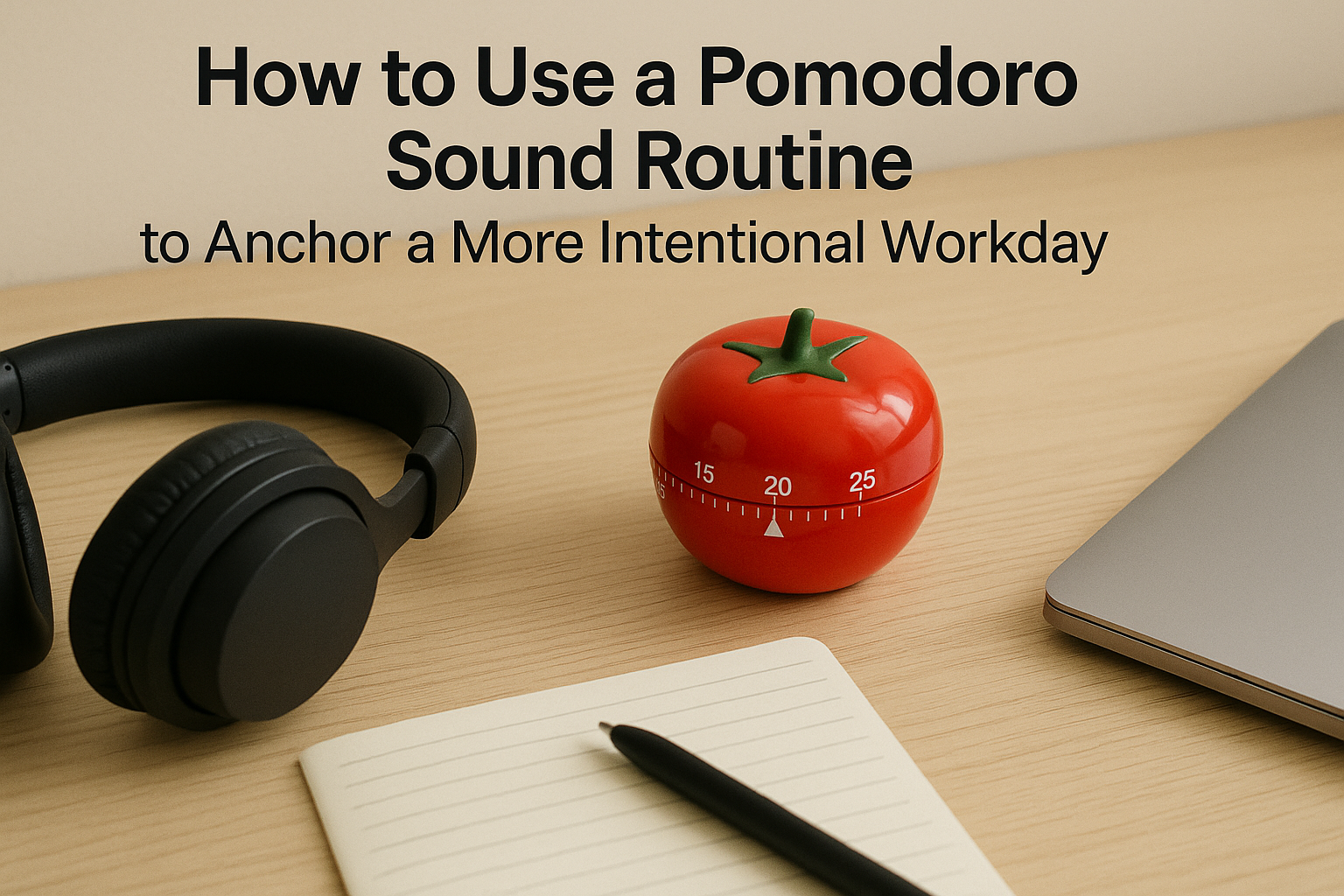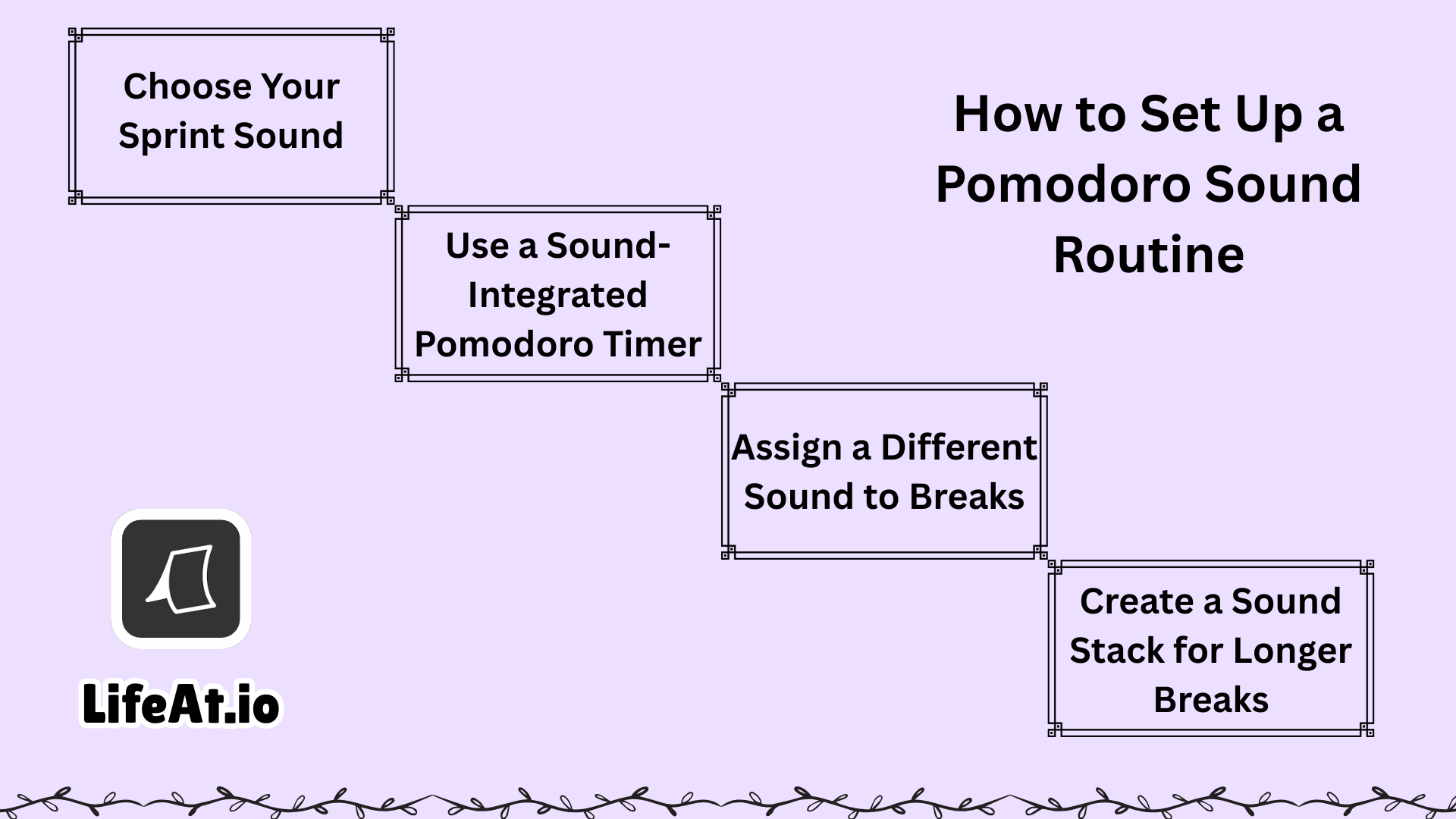There’s something oddly comforting about a ticking timer. A soft bell. A favorite focus track starting just as your coffee hits the perfect temperature.
It’s not just aesthetic—it’s neurological.
The Pomodoro Technique has been around since the late '80s, but pairing it with sound turns it into more than a time management method. It becomes a ritual. One that can bring rhythm, intention, and calm to even your most chaotic workdays.
If you’ve ever found yourself spiraling between Slack notifications, 15 open tabs, and a creeping sense of “I’m behind,” this one’s for you.
Let’s talk about how to build a Pomodoro sound routine that doesn’t just keep you on track—but brings you back to yourself.

First, What Is the Pomodoro Technique?
At its core, the Pomodoro method is simple:
Work in short, focused sprints (typically 25 minutes) followed by brief breaks (5 minutes). After four sprints, you take a longer break (15–30 minutes).
Why it works:
- It taps into your brain’s natural attention cycle
- It prevents burnout by giving your mind structured rest
- It rewards small wins, reducing overwhelm
Now, when you layer in sound, you create an auditory rhythm that your brain learns to recognize—on cue.
Why Pair Sound with Pomodoro Intervals?
Because your brain loves structure—especially when it’s gentle and sensory.
Pairing the right sound with your work and break blocks reinforces habit through repetition.
When used consistently, your brain starts to associate:
- This track = time to focus
- This bell = time to pause
- This ambient sound = break mode activated
Suddenly, you’re not relying on motivation. You’re anchored in ritual.

How to Set Up a Pomodoro Sound Routine
Here’s how to design a routine that uses sound as your anchor throughout the day:
1. Choose Your Sprint Sound
Pick a focus soundscape that helps you enter flow. This might vary based on the task or time of day. A few ideas:
- Lo-fi beats for creative writing or ideation
- Brown noise or alpha waves for deep focus
- Piano or instrumental playlists for calm, steady work
Keep it consistent during each sprint so your brain learns, this is go time.
🧠 Pro tip: Avoid songs with lyrics during sprints—they activate the language center in your brain and can interrupt concentration.
2. Use a Sound-Integrated Pomodoro Timer
You don’t have to juggle apps. Use a digital tool like:
- LifeAt.io – offers built-in Pomodoro timers with ambient soundscapes
- Focus Keeper, Flow, or Be Focused – minimalistic apps with optional sound integrations
- Or just combine a Spotify playlist + a timer on your phone
Set your 25-minute timer, press play, and let the session carry you.
3. Assign a Different Sound to Breaks
Here’s where the magic happens.
When the sprint ends, don’t just stop—transition.
Switch to:
- Nature sounds (rain, birds, waves)
- Soft ambient music
- A “reset” playlist that tells your nervous system to shift gears
This reinforces rest as part of your rhythm—not a deviation from it.
4. Create a Sound Stack for Longer Breaks
After four sprints, when it’s time for a longer break, give yourself audio variety:
- Uplifting, feel-good songs to stretch or take a walk
- Podcasts for light listening if you need inspiration
- Total silence if your brain needs decompression
The shift in audio signals that this is a deeper pause—and a reward.
Sample Pomodoro Sound Routine (Morning Example)
.png)
Repeat or remix this flow in the afternoon, adjusting sound based on your energy level or chronotype.
Bonus: Anchoring Time of Day with Specific Playlists
You can also start associating certain times of day with certain sounds:
- Morning = lo-fi to ease in
- Afternoon = warm instrumental or binaural beats
- Late afternoon = nature sounds or silence for recovery
Eventually, your brain gets the memo before the playlist even starts.
What This Actually Solves
If you’ve been feeling scattered, inconsistent, or overwhelmed by the open-endedness of remote or hybrid work, a Pomodoro sound routine creates a sense of rhythm without rigidity.
It tells your nervous system:
- When to start
- When to pause
- When to rest
- When to return
And maybe most importantly, it helps you feel like your day has a heartbeat again—like you’re not just reacting to noise, but choosing your own tempo.
Final Thought: It’s Not Just Productivity—It’s Regulation
The true benefit of this practice isn’t getting more done.
It’s working in a way that’s gentle on your brain, kind to your body, and repeatable on the tough days.
Sound is one of the fastest ways to shape emotion, attention, and energy.
So the next time you need to ground yourself in a workday that feels too big—don’t just make a to-do list.



.avif)